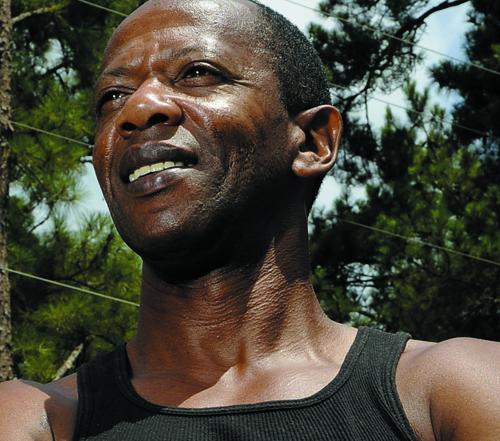This is “Social Learning and Social Cognition”, chapter 2 from the book Social Psychology Principles (v. 1.0). For details on it (including licensing), click here.
For more information on the source of this book, or why it is available for free, please see the project's home page. You can browse or download additional books there. To download a .zip file containing this book to use offline, simply click here.
Chapter 2 Social Learning and Social Cognition
DNA Evidence Sets Free Another Mistakenly Identified Prisoner

Rickie Johnson was freed from prison in Louisiana on January 14, 2008, after serving 26 years in prison for a crime he did not commit.
Photo courtesy of Greg Pearson Photography.
On July 12, 1982, a woman in northwest Louisiana was held at gunpoint and raped. During the four hours that the rapist stayed in her house, he identified himself as Marcus Johnson from Leesville, Louisiana.
When the victim reported the attack, the police could find no information about a Marcus Johnson, but they did find a Rickie Johnson who had once been arrested on a minor traffic charge. Mr. Johnson became the only suspect in the case.
The victim was shown a photo lineup of three men who were listed as potential perpetrators, although the image of Johnson was eight years old. The victim identified Johnson as the perpetrator, even though he looked very little like the description she had given of the attacker after the rape.
Johnson was charged with aggravated sexual assault and was tried in Sabine Parish, Louisiana. During the trial the victim told the jury that she was “positive” that he was the perpetrator and there was “no question in [her] mind.”
In 2007, however, Johnson’s innocence was determined with forensic DNA testing, a technology that was not available at the time of the crime.
Rickie Johnson’s case is only one of many recent DNA exonerations, most of which stem from eyewitness misidentifications. In fact, eyewitness misidentification is the single greatest cause of wrongful convictions. Over the past 10 years, almost 400 people have been released from prison when DNA evidence confirmed that they could not have committed the crime for which they had been convicted. And in more than three-quarters of these cases, the cause of the innocent people being falsely convicted was erroneous eyewitness testimony (Wells, Memon, & Penrod, 2006).Wells, G. L., Memon, A., & Penrod, S. D. (2006). Eyewitness evidence: Improving its probative value. Psychological Science in the Public Interest, 7(2), 45–75.
According to the Innocence Project (http://www.innocenceproject.org), “The human mind is not like a tape recorder; we neither record events exactly as we see them, nor recall them like a tape that has been rewound.”
In October 1999, the U.S. Department of Justice released the first national guide for collecting and preserving eyewitness evidence. The guide was commissioned by U.S. Attorney General Janet Reno (http://www.wic.org/bio/jreno.htm) and consisted of a panel of experts, including social psychologist Gary Wells (http://www.psychology.iastate.edu/~glwells/bio2001.html), the world’s foremost authority on the psychology of eyewitness identification.
Although being able to correctly identify the perpetrator of a crime that we have observed is fortunately not part of our everyday social activities, we do need to be able to accurately learn about the people that we interact with every day. Our remarkable abilities to size up and remember other people are enhanced by our affective and cognitive capacities. In this chapter, our focus will be on cognition, and we will consider how we learn about, remember information about, and judge others (Fiske & Taylor, 2007; Macrae & Quadflieg, 2010).Fiske, S. T., & Taylor, S. E. (2007). Social cognition, from brains to culture. New York, NY: McGraw-Hill; Macrae, C. N., & Quadflieg, S. (2010). Perceiving people. In S. T. Fiske, D. T. Gilbert, & G. Lindzey (Eds.), Handbook of social psychology (5th ed., Vol. 1, pp. 428–463). Hoboken, NJ: John Wiley & Sons. Then, in Chapter 3 "Social Affect", we will turn to a focus on the role of affect in these same processes.
Most generally, this chapter is about social cognitionMental activity that relates to social activities and helps us meet the goal of understanding and predicting the behavior of ourselves and others., the mental activity that relates to social activities and helps us meet the goal of understanding and predicting the behavior of ourselves and others. A fundamental part of social cognition involves learningRelatively permanent change in knowledge that is acquired through experience.—the relatively permanent change in knowledge that is acquired through experience. We will see that a good part of our learning and our judgments of other people operates out of our awareness—we are profoundly affected by things that we do not know are influencing us. But we also consciously think about and analyze our lives and our relationships with others, seeking out the best ways to fulfill our goals and aspirations.
As we investigate the role of cognition in everyday life, we’ll consider the ways that people use their cognitive abilities to make good decisions and to inform their behavior in a useful and accurate way. We’ll also consider the potential for mistakes and biases in human judgment. We’ll see that although we are generally pretty good at sizing up other people and creating effective social interactions, we are not perfect. And we’ll see that the errors we make frequently occur because of our reliance on our schemas and attitudes and a general tendency to take shortcuts through the use of cognitive heuristicsAn information-processing rule of thumb that enables us to think in ways that are quick and easy but may sometimes lead to error.: information-processing rules of thumb that enable us to think in ways that are quick and easy but that may sometimes lead to error. In short, although our cognitive abilities are “good enough,” there are definitely some things we could do better.




